MARIANI’S
Virtual
Gourmet
JUNE 21,
2015
NEWSLETTER

HAPPY
FATHER'S DAY!
IN THIS ISSUE
VEGAS IS BACK!
By John A. Curtas
CELEBRITY WATCHING IS
WAY BETTER UPTOWN
By John Mariani
NEW YORK CORNER
Via Quadronno and Marta
By John Mariani
❖❖❖
VEGAS IS BACK!
By John A. Curtas

Yee ha! Vegas
is back, baby, with a vengeance, and the doldrums
of 2009-2014 are now as forgotten as last night’s
losing streak at the craps table. You can see it
in the faces of waiters; you can feel it in the
upbeat attitudes of the staffs in hotels all
around town. Dining rooms are full, check averages
are up, and bargains are getting tougher to find
than a loose slot machine. Las Vegas Restaurant
Revolution 3.0 (the first two versions rolled out
in 1998 and 2005) may be a bit more modest in
scope, but it’s just as tasty, with big-hitter
chefs expanding their repertoires without diluting
their brands. Here are the big three, all opened
within the past nine months.
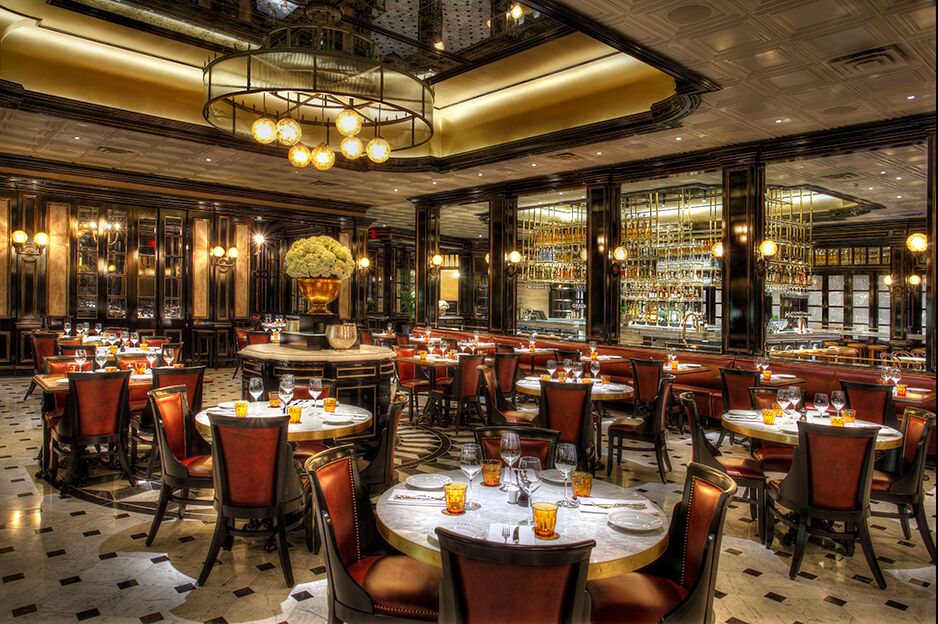 BARDOT
BRASSERIE
BARDOT
BRASSERIE
Aria Hotel and Casino
3730 Las Vegas Blvd. South
702-590-8611
aria.com/dining/restaurants/bardot-brasserie
French bistros and brasseries are
about as hip as a dickey, but in the hands of
Michael Mina (below)
and Chef de Cuisine Joshua Smith the classic and
time-worn suddenly seems as fresh and effervescent
as the rosé champagne you will be offered here to
begin your meal. Bardot Brasserie is resolutely a
copy of a Parisian brasserie, with lots of
traditional-yet-modernized bistro recipes thrown
in for good measure. No matter what you call it,
Mina and Smith’s cooking has had this place packed
from day one.
All bistro cooking is based on classics like omelet aux
fines herbes, steak frites
and croque
Monsieur or Madame.
Here, each of these (along with a superb soup à l’oignon
gratinée
and steak tartare) are done with top-shelf
ingredients and attention to detail you usually
don’t  find with this type of
cooking. The croque
Madame starts with good brioche toast, upon
which lightly cured, not-too-thinly-sliced French
ham is placed, along with some Gruyere that melts
into that soft, eggy bread, the whole then bathed in
a proper Mornay sauce that emits the subtle
creamy-silky tang of a cheesy béchamel. Screw up any
one of these ingredients and you have a lousy ham
and cheese sandwich; pay close attention to each and
you have a thing of beauty.
find with this type of
cooking. The croque
Madame starts with good brioche toast, upon
which lightly cured, not-too-thinly-sliced French
ham is placed, along with some Gruyere that melts
into that soft, eggy bread, the whole then bathed in
a proper Mornay sauce that emits the subtle
creamy-silky tang of a cheesy béchamel. Screw up any
one of these ingredients and you have a lousy ham
and cheese sandwich; pay close attention to each and
you have a thing of beauty.
Smith’s frisée aux
lardons salade is nothing short of textbook
perfect, and entrees – from skate wing to roast
chicken – remind you, with every bite, why this food
has again become so popular. Dishes like foie gras
parfait, Parisian gnocchi and moules
marinières, duck wings Maltaise, and escargots
Bardot (encased in puff pastry with Chartreuse
butter) are as much a “must-try” as a show-stopping
lobster Thermidor, bathed in a brandy cream and
topped with an ethereally rich Béarnaise sauce – a
dish at once a throwback and emblematic of Vegas’s
regained, Bacchanalian swagger.
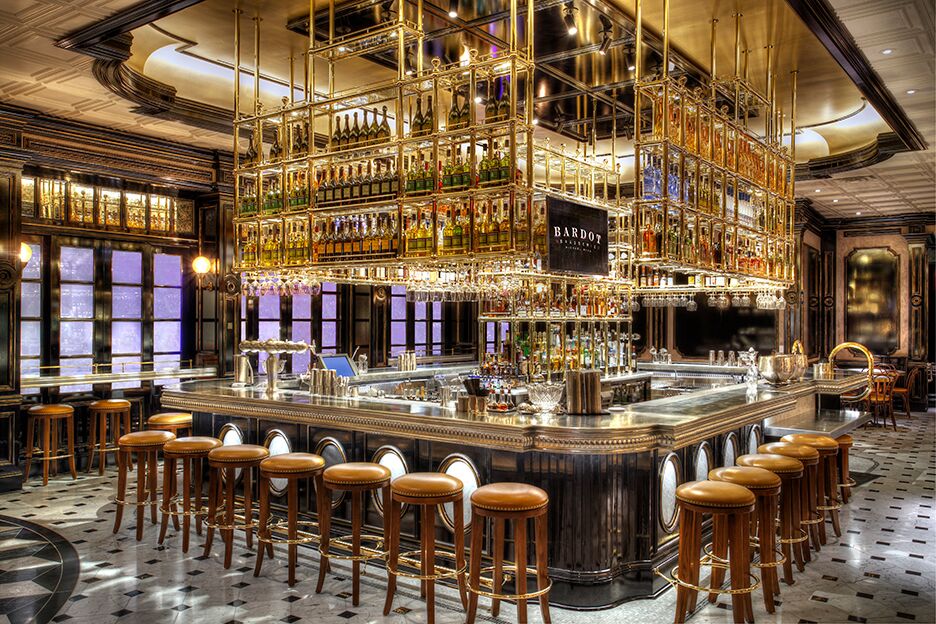 The dining
room also hits all the right notes, carried through
the glass, wood and polished metal theme as if it
were lifted straight from the Left Bank. There are
the obligatory cocktails ($12) and a special list of
four rosé wines by the glass that go perfectly with
this food.
The dining
room also hits all the right notes, carried through
the glass, wood and polished metal theme as if it
were lifted straight from the Left Bank. There are
the obligatory cocktails ($12) and a special list of
four rosé wines by the glass that go perfectly with
this food.
More than a few friends have
asked me how BB compares with db Brasserie, the
other relatively new French restaurant in Vegas with
a similar concept. Summoning my most diplomatic
demeanor (something at odds with my personality,
generally), all I can say is Daniel Boulud’s
brasserie feels like a corporate calculation, made
to feature the “best hits” of his other restaurants.
As such, it’s always lacked a theme and suffers for
it. (He should’ve had the guts to go
full-offal, à la Bar Boulud in NYC, and feature
his panoply of sausages and cured meats, but the
bean counters said otherwise.) Mina, on the other
hand, made the commitment to go balls-to-the-wall
bistro here, and make these cuisine
classique recipes sing with their own special
tweaks and twists, and, because of it, the passion
behind these plates is palpable.
Hors d’oeuvres $14-$27 (for the
charcuterie platter), with soups and salads
$12-$18, and mains $24-$48 (for the lobster
Thermidor).
BAZAAR MEAT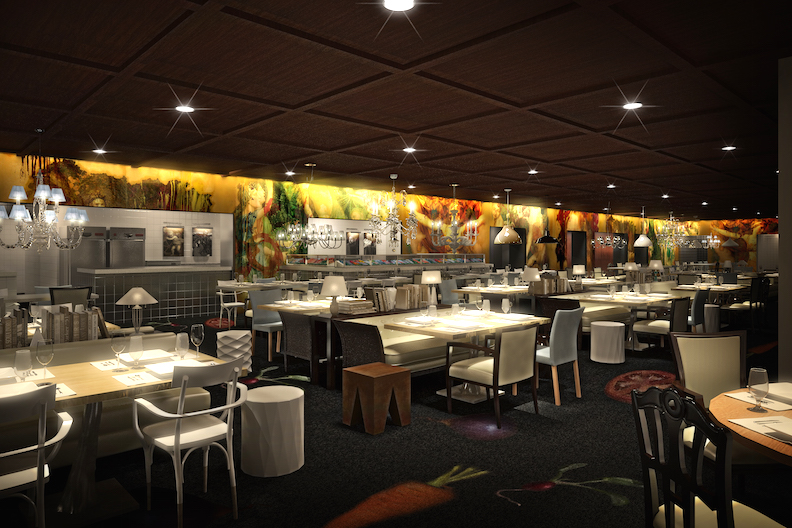
SLS Hotel
2535 Las Vegas Boulevard South
855-761-7757
sbe.com/restaurants/locations/bazaar-meat
Calling Bazaar Meat a good
steakhouse is like calling Liz Taylor just another pretty face.
What it is is a meat emporium, pure and simple,
featuring the best meat on the hoof money can buy.
Las Vegas may not be the steakhouse capital of the
world, but it runs a close second to the Big Apple,
and with José Andrés’ entry into the fray (this is
his third Las Vegas restaurant) things have gotten a
lot beefier, with an equal amount of pulchritudinous
pig thrown in to get your heart beating faster.
Everyone begins with Jamón Iberico de Bellota
(below),
the creamy, gamey and dense Spanish ham that is
truly the ham all hams want to be. That is probably
the easiest decision you’re going to make as you
tackle the two-sided plastic board of the dauntingly
large menu – one side comprised of appetizers,
small bites, carpaccios and other beginnings, while
the other is all about the big-ticket items. But
it’s 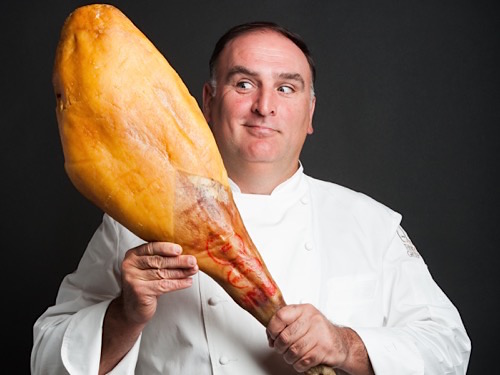 no understatement to say
you could comprise an entire feast from the giant
pork skin chicharron,
croquetas de pollo (chicken-béchamel fritters
that come stuffed in a little shoe), tiny Reuben
sandwiches encased in micro-thin, crispy “air
bread,” and a couple of tartares: the table-side
tossed classic, and the beefsteak tomato, which is a
triumph of trompe l’oeil ingenuity. In fact, the
tomato tartare might be the most jaw-dropping thing
on the menu; it resembles raw chopped meat, but
surprises the palate with a burst of sweet and
acidic tomato ripeness – the perfect expression of
summer eating.
no understatement to say
you could comprise an entire feast from the giant
pork skin chicharron,
croquetas de pollo (chicken-béchamel fritters
that come stuffed in a little shoe), tiny Reuben
sandwiches encased in micro-thin, crispy “air
bread,” and a couple of tartares: the table-side
tossed classic, and the beefsteak tomato, which is a
triumph of trompe l’oeil ingenuity. In fact, the
tomato tartare might be the most jaw-dropping thing
on the menu; it resembles raw chopped meat, but
surprises the palate with a burst of sweet and
acidic tomato ripeness – the perfect expression of
summer eating.
But sticking to the first side of the menu
means you’d miss out on half the fun, such as bison
carpaccio
or the giant spiral of butifarra
Catalan-style sausage – too much for two, but just
the right nibble for a table of hungry fressers. The
conceit of this menu is you can go big or small, raw
or cooked, large-format or tiny tapas, depending on
your mood and/or the size of your party. It’s really
quite ingenious on Andrés’ part to re-invent the
American steakhouse as a Spanish food hall, but as
huge as the enterprise is (360 seats), there’s an
intimacy to the space (and a softness to the
lighting) that blunts any sense you’re in a
head-em-up-and-move-em-out corporate cattle call.
Another stroke of brilliance is packing a
meat-obsessed menu with all sorts of top-notch
vegetarian and seafood items. Whether it’s a roasted
Padron pepper or a cauliflower “steak” with pine
nuts and preserved lemon, or
drop-your-fork-delicious Brussels sprouts “petals”
with “lemon air,” you’ll find plenty of antioxidants
to applaud without getting close to any dead animal
flesh.
Pescatarians won’t complain
either, since the raw bar here puts out the sweetest
clams this side of Nantucket – these bathed in leche de tigre
(tiger milk) – as well as top-shelf oysters, either
raw, grilled or smoked.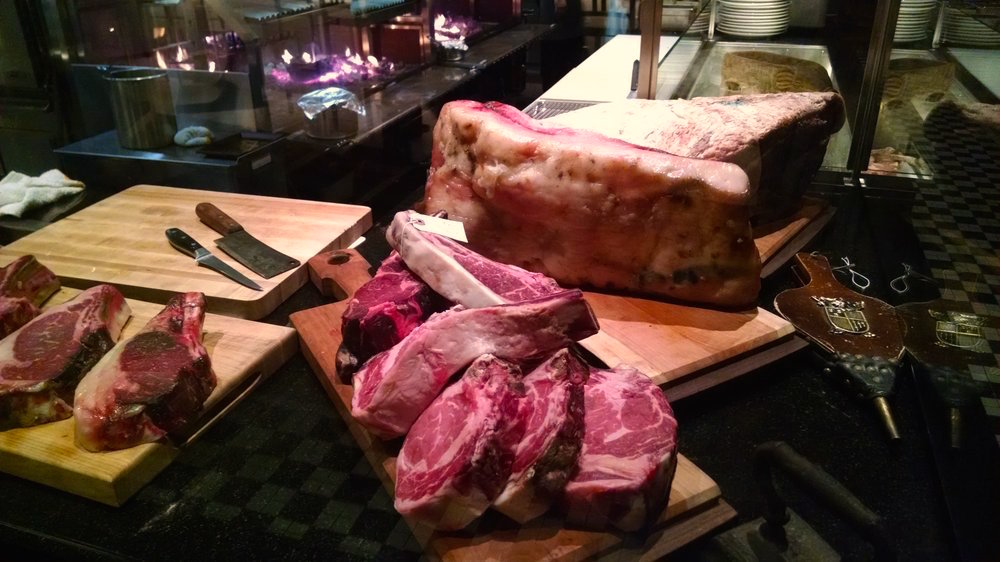
Now, for
the show stoppers. As good as the oak-grilled,
bone-in, rib eye steaks are (and the
priced-by-the-pound Washugyu Ranch wagyu/Angus and
the Harris Ranch Angus are all you could want in a
piece of beef), it is the suckling pig that elicits
the most huzzahs as it is paraded through the dining
room. A whole one (around ten pounds) will set you
back $520, but is more than enough for a table of
6-8. The good news is $125 will bring a quarter of
one of these beauties to your two-top, and will have
both of you swooning over the meat-candy quality of
the crispy-sweet skin, and the melt-in-your-mouth
quality of the flesh.
Andrés’ chateaubriand is old
school meat eating at its best, as he reinvigorates
this warhorse by pairing it with a classic Périgord
sauce that would pass muster in any high-falutin’
frog pond. No self-respecting steakhouse is without
its Japanese wagyu/Kobe options these days, and the
Hyogo Prefecture Eye of the Rib is requisitely fatty
and rich, which you will have to be to afford it
($100 for four ounces).
There’s always braised lamb neck
with fried oysters and oyster “catsup,” and a
Tortilla Sacromonte egg omelet with kidneys,
sweetbreads, and marrow, which may be the last word
in offal edibles.
After all
that, desserts may seem like overkill, but you
really shouldn’t miss the sinful things this kitchen
does with foie gras – putting it between two
house-made graham crackers in “José’s s’mores,” or
serving a soupçon of sweet and savory foie gras soup
with corn espuma
(foam), or yet
another espuma
of succulent duck organ, paired with peanut butter
and honey in something called “Foieffle” – none of
which is listed as a dessert, but all of which
should be. If you still have a hankering for
something sweet after all that, then you’re a better
man than I am.
Starter courses
and small bites $8-$32. Steaks from $38 to $80/lb.
for the Wagyu/Angus cuts, with sides and
vegetables all in the $10-$15 range.
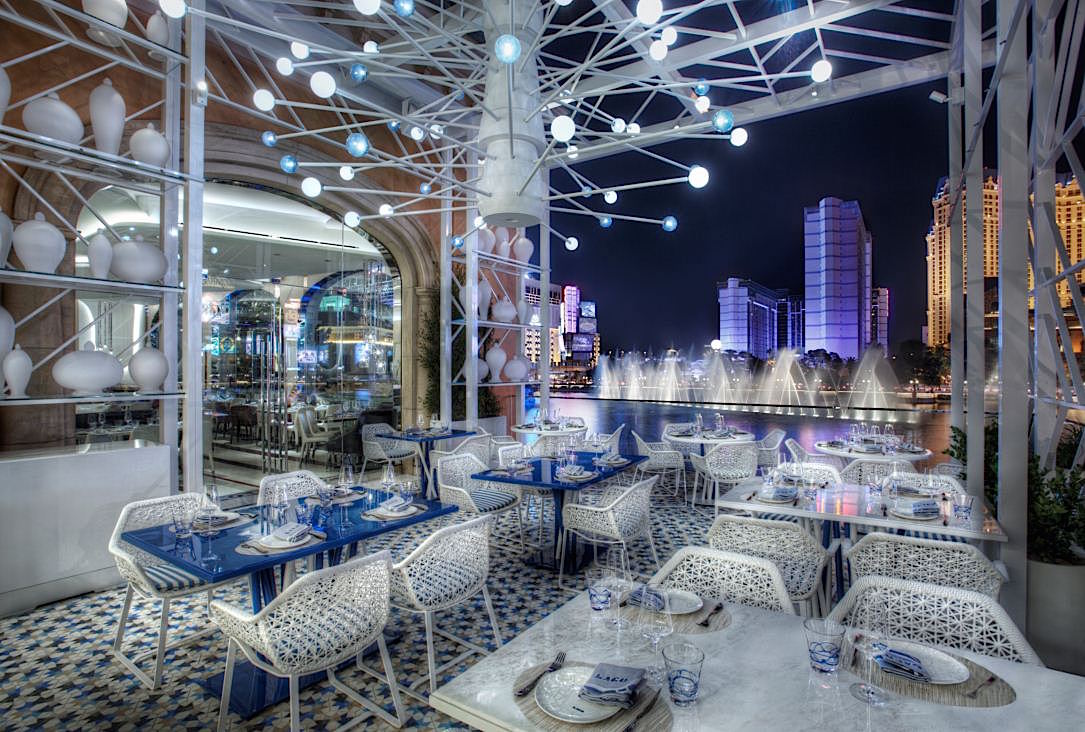 LAGO BY JULIAN SERRANO
LAGO BY JULIAN SERRANO
Bellagio Hotel and Casino
3600 Las Vegas Boulevard South
866-259-7111
bellagio.com/restaurants
Julian
Serrano
(below) may
not be a Las Vegas native, but after seventeen years
here, we pretty much claim him as our own, since he
is, by far, our best and most successful local chef.
He is also one of the very few name chefs who
actually live and work in the city full-time.
His Picasso
continues to dazzle as much as it did on opening
night in 1998, and his namesake restaurant – Julian Serrano
in the Aria Hotel – brings forth the flavors of his
homeland and shows his range as both a chef and
restaurateur. It certainly qualifies as one of the
best Spanish restaurants in America, and can go toe
to toe with Jaleo down the street for the best
traditional or modern tapas in town. Serrano –
unlike many lesser chefs and most famous ones, which
would include both Michael Mina and Jose Andrés – is
a constant presence in both restaurants, and he
toggles between them every night they’re open,
checking on the kitchen and guests without breaking
a sweat.
With the opening of Lago by
Julian Serrano, he has decided to leave Spanish and
high-toned French-Mediterranean cooking behind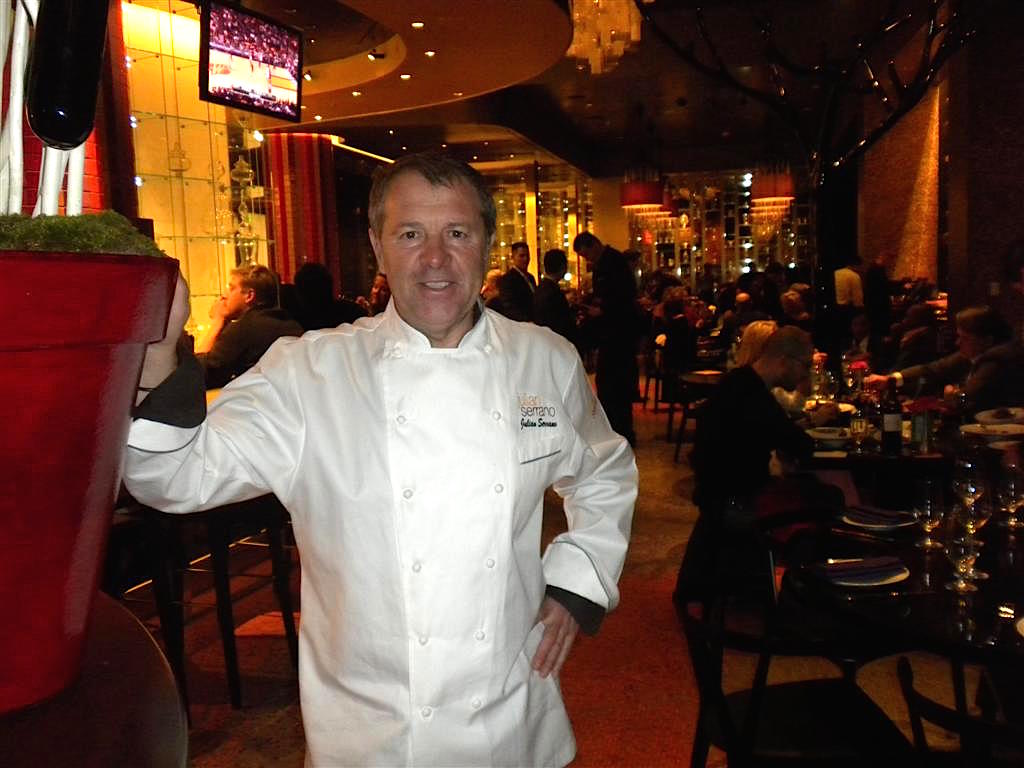 to bring
forth Italian small plates, done family-style, in a
modernist, cutting-edge setting, which tries to
simultaneously please the purists and appeal to the
party-as-a-verb crowd.
to bring
forth Italian small plates, done family-style, in a
modernist, cutting-edge setting, which tries to
simultaneously please the purists and appeal to the
party-as-a-verb crowd.
Whether you like the room or not
will pretty much depend on your age. The décor is as
far away from the defunct Circo (in whose spot it
sits at the Bellagio) as the Jersey Shore is from
the Amalfi Coast. “Cutting edge” is the kindest way
to describe the overbright, overwhite, aggressively
casual-chic décor, although “cruise ship moderne”
and “all-night drug store waiting room” may
impolitely creep into your assessment if you’re not
feeling charitable.
If
all that illuminated whiteness interferes with the
enjoyment of your meal, take solace in knowing that
restaurants these days are not built with an eye
towards maximizing enjoyment of food. That rather
quaint notion – that upscale eateries are there to
soothe your fevered brow and quell your appetite –
is so 2005. In the dystopian restaurant universe of
2015, it seems, it’s far better to catch the eye
than provoke the palate. Gastronomic bliss takes a
back seat to building buzz these days, and Vegas’s
best restaurants, with a few exceptions, are as much
about feeding (and feeding off of) the nightclubs as
they are about what they are actually feeding you.
Thus does Lago perfectly fit the zeitgeist of our
current age – built to grab your attention, cause a
stir, and capture those clubbers, coming and going.
This is not to say that one
cannot dine well here. Rather, only that the food,
good as it is, plays second billing to the scene.
Whether you’re tying one on or not, the small pizzette
are a good way to start. Unlike the focaccine,
their crusts are thin and crackly, designed to
highlight the 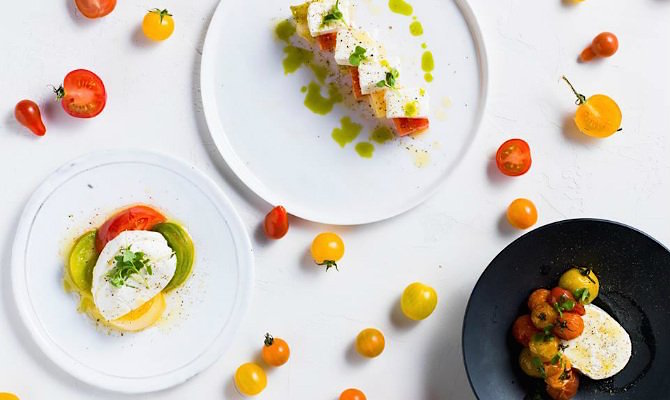 cheeses –
smoked provolone, house-made mozzarella, bufala ricotta
–
not overwhelm them with dough. Just as satisfying
are the toasted crostini:
the n'duja
(a fine, almost pureed spread of spicy pork sausage
and Gorgonzola) and the chicken liver with capers
and pepperoncino will get your salivary juices
properly flowing.
cheeses –
smoked provolone, house-made mozzarella, bufala ricotta
–
not overwhelm them with dough. Just as satisfying
are the toasted crostini:
the n'duja
(a fine, almost pureed spread of spicy pork sausage
and Gorgonzola) and the chicken liver with capers
and pepperoncino will get your salivary juices
properly flowing.
Everyone seems to get good fish
in Vegas these days (thank you Fed Ex), and
Serrano’s pesce
– be it in
crudo (raw) form or a baked whole orata (sea
bream) – are as good as you’ll find this far from an
ocean. There’s no faulting them, or most of the
pastas (although the veggie “ragù” with the
pappardelle really doesn’t bring much to the party).
The standouts are the risottos: alla trippa e
funghi (tripe and mushrooms) or with red wine
and burrata.
Both are done al
dente (somewhat firm, as opposed to soupy),
and both are so vivid with their primary flavors you
will forget, for a moment, that you’re in an
American restaurant run by a Spanish chef that looks
like a Caribbean cruise ship.
If you peer
into the open kitchen, you’ll see the reason why
these risottos, and most of the pastas, sing as they
do. Serrano had the good sense to employ Nico Chessa
as his chef de cuisine. Chessa is a veteran of Piero
Selvaggio’s Valentino group, and he delivers solid
renditions of osso buco, veal piccata and grilled
lamb chops scottadito,
as well as a potato gnocchi with lobster knuckles
that will have you fighting for the last bite. About
the only dish that I could fault was the vitello
tonnato (chilled, thin slices of veal with
tuna caper dressing), only because there was not
enough sauce. Of course, there is never enough sauce
for me. I can never get enough of a great sauce,
unlike the décor here, of which you will quickly get
too much.
Small plates of
pizzas, soups, salads, fish, meat and pastas are
priced between $10 and $20; main courses $28-$60.
❖❖❖
CELEBRITY
WATCHING
IS WAY BETTER UPTOWN
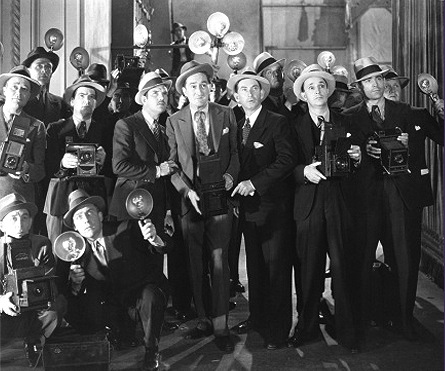 By John
Mariani
By John
Mariani
The
media’s
coverage of celebrity sightings is as old as when
Napoleon dined with Josephine at Le Grand Véfour,
and in the late 19th
century NYC’s social columnists dutifully reported
on who dined at Delmonico’s, Louis Sherry’s, and
Rector’s. Later
on, with Hollywood in full swing, The Brown Derby,
Café Trocadero, and Chasen’s always had photogs
outside, and the rest of the world caught on with
the rise of the paparazzi of Rome, who flash-bulb
shot every star on the Via Veneto.
Celebs have always had their favorite spots,
usually places where they feel most cosseted—from
Spago in L.A. to The Pump Room in Chicago—and
nowhere is this more true than in NYC, where, if the
local paparazzi are not quite as viciously intrusive
as those of Hollywood and London, they can still be
a repulsive nuisance.
For this reason, if you happen to be a
celebrity idolater who wants to eat where your
favorite actor or actress eats, you might as well
stay clear of the city’s trendiest restaurants of
the moment, because the stars overwhelmingly avoid
them.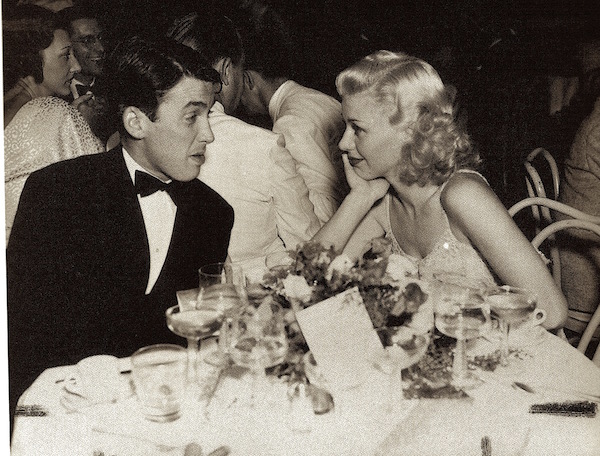
Why would, say, Brad Pitt want to eat at a
20-seat storefront on the Lower East Side or
Jennifer Aniston trek out to a gastro-pub Brooklyn
when they can have a far more relaxed meal with
colleagues who long ago found places uptown far less
likely to cause them discomfort?
It is hardly surprising, then, that celebs
rarely venture south of midtown—unless it’s a Brian
McNally restaurant like Balthazar or Minetta Tavern,
where their names are on the V.V.V.I.P. lists. To prove
my point, take a look at two listicles that came out
this week, one, in New York
Magazine’s Grub Street about celeb sightings (many
culled from the New York Post’s Page Six) this past
week: Stephen Colbert at Isabella’s (Columbus Ave.
& 77th St.); Bon Jovi
at Beautique (West 58th
St.); Jennifer Lopez at Good Enough to Eat (Columbus
& 85th.); David Spade
at Hunt & Fish Club (44th
& 7th Ave.); Michael
Moore at Swifty’s (Lexington & 73rd).
The
only cited celebs found south of 42nd
Street were Bill
Murray and Bryan Cranston at Cookshop in the Meat
Packing District.
James Stewart and
Ginger Rodgers at Café Trocadero
Now
look at Zagat’s list of the “Hottest” restaurants in
NYC: The
Clocktower; O Ya; Fuku
sandwich shop; Oiji; Dirty Candy; Lupulo;
Streetbird, and others, almost all way down town, in
Brooklyn or up in Harlem.
Only Ralph Lauren’s tony midtown Polo Club,
which is rich in nightly celebs, made the list.
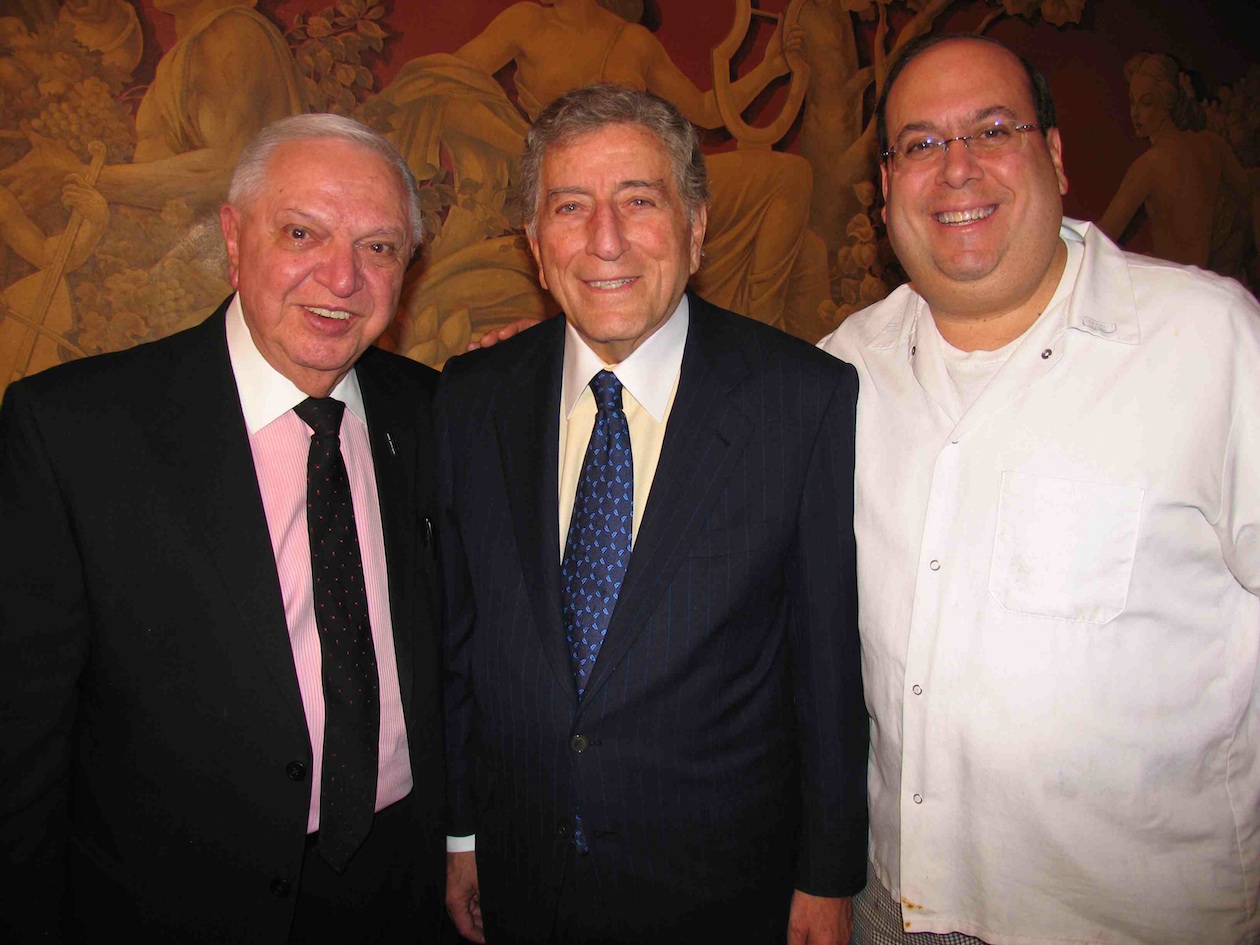 I’m sure some
stars do occasionally slum and bring their glamour
to a hot new eatery serving chicken wings and
kabobs, but you’re much more likely to see them in
old standbys with their colleagues or in places
right around the corner from where they work, like
ABC and CBS on the Upper West Side, NBC at Rock
Center, the theater luminaries on Broadway, the
artists and actors at Lincoln Center, etc. God knows
where Anna Wintour of Vogue and
Graydon Carter of Vanity Fair
are entertaining fashionistas and cover models out
of the new Condé-Nast headquarters down at One World
Trade Center building. It’s hard to imagine Katy
Perry or Caitlyn Jenner chowing down with Ann and
Graydon at Adrienne’s Pizza Bar or Mad Dog &
Beans.
I’m sure some
stars do occasionally slum and bring their glamour
to a hot new eatery serving chicken wings and
kabobs, but you’re much more likely to see them in
old standbys with their colleagues or in places
right around the corner from where they work, like
ABC and CBS on the Upper West Side, NBC at Rock
Center, the theater luminaries on Broadway, the
artists and actors at Lincoln Center, etc. God knows
where Anna Wintour of Vogue and
Graydon Carter of Vanity Fair
are entertaining fashionistas and cover models out
of the new Condé-Nast headquarters down at One World
Trade Center building. It’s hard to imagine Katy
Perry or Caitlyn Jenner chowing down with Ann and
Graydon at Adrienne’s Pizza Bar or Mad Dog &
Beans.
Celebs are as susceptible to kindly hosts and
comfort food as any of us, which is why the wall at
Patsy’s Restaurant in the Theater District are hung
with scores of star photos, including Michael Bublé,
Al Pacino, Placido Domingo, Alec Baldwin, Tom Hanks,
Madonna, David Letterman, Oprah Winfrey, Keanu
Reeves, Robert DeNiro, Don Rickles, Liza Minnelli,
and Chevy Chase. Recently George Clooney and
his wife Amahl came by for dinner.
Tony Bennett with Joe
and Sal Scognamillo, owners of Patsy's
Restaurant
So, if you are dying to gaze across a dining room at
your favorite stars, here are your best bets in NYC.
They’re not necessarily the best restaurants in the
city—though many are—but they are rife with stars.
❖❖❖
TWO
MADISON AVENUE ITALIAN
EATERIES GO ALL DAY AND NIGHT
By
John Mariani
 VIA
QUADRONNO
VIA
QUADRONNO1228 Madison Avenue (at 88th Street)
212-369-9000
viaquadronno.nyc
Via
Quadronno on Madison Avenue is one of two
Italian eateries by that name (the other is on
73rd Street), borrowed from a street in the
Porta Romana district of Milan, where, at Bar
Quadronno, the panino
sandwich is said to have originated. One of the
panini makers there was Giuseppe Tusi, who came
as a consultant to start up the NYC branches.
Open for breakfast, lunch and dinner, VQ
(as I’ll call it) is set on two levels: downstairs
is the pastry and sandwich counter, with a few
tables to the rear, and upstairs a quiet,
skylighted room that is very much a respite from
the city’s sounds. In the morning people flock 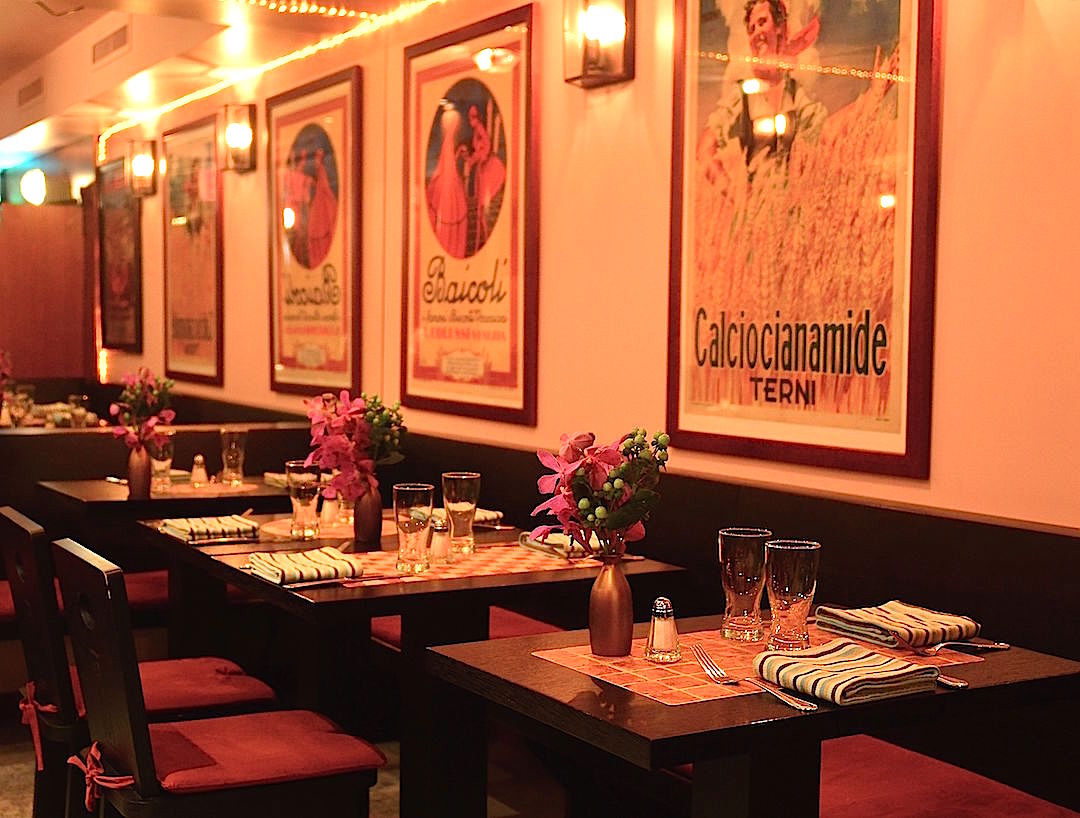 here for the kind of basic Italian
pastries and espresso and cappuccinos so hard to
find elsewhere in town, without any of those
garishly flavored coffees offered at Starbucks.
here for the kind of basic Italian
pastries and espresso and cappuccinos so hard to
find elsewhere in town, without any of those
garishly flavored coffees offered at Starbucks.
The panini
crowd starts before noon and continues through and
after lunch, and dropping by VQ is a good idea if
you’re visiting the nearby Guggenheim Museum or
trekking through the vast Metropolitan Museum on
Fifth Avenue.
In the evening things are slower, the pace
more civilized, the ad posters Italian, and people
take their small tables to relax in front of the
faux fireplace, have a negroni and eat fine
renditions of classic Italian cuisine. A few
dishes--the best on the menu and the reason for
going to VQ--stray from what you’ll find elsewhere
around the city, and most are deftly done,
starting with tender braised baby octopus with red
onions in a light tomato sauce ($15.50).
Full pasta portions are generous, and right
now is the best time to have one with basil pesto,
such as al
dente fusilli and pine nuts (at a very
reasonable $16.50). The hollow tubes called paccheri
come with an unusual potato sauce, walnuts and a
touch of summery rosemary ($18.50), and there is a
risotto of the day ($22) that is a very good dish
to split for two.
The night I visited the perfectly cooked
rice came with smoked mozzarella and sweet dried
figs--not something I’ve encountered elsewhere in
NYC.
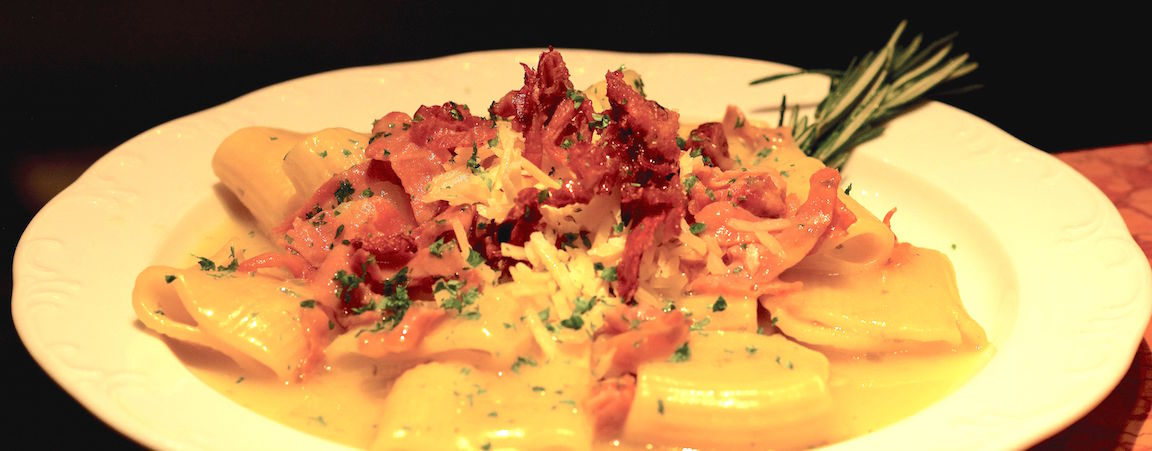 Large
shrimp have a good dose of garlic and a nice spike
of pepperoncino
atop quickly cooked spinach ($28.50), and if you
enjoy a fillet of branzino, VQ does a
splendid pan-roasted one with capers, olives and
cherry tomatoes, with broccoli di rabe on the side
($27.50). For meats the breaded veal cutlet
Milanese-style ($53.50) is good, if not
exceptional, while the grilled, sliced chicken (at
just $22) is juicy to the bone, with a mixed
mushrooms sauce and buttered spinach. All main
courses also get a side of fingerling potatoes.
Large
shrimp have a good dose of garlic and a nice spike
of pepperoncino
atop quickly cooked spinach ($28.50), and if you
enjoy a fillet of branzino, VQ does a
splendid pan-roasted one with capers, olives and
cherry tomatoes, with broccoli di rabe on the side
($27.50). For meats the breaded veal cutlet
Milanese-style ($53.50) is good, if not
exceptional, while the grilled, sliced chicken (at
just $22) is juicy to the bone, with a mixed
mushrooms sauce and buttered spinach. All main
courses also get a side of fingerling potatoes.
This is a place to indulge yourself with
housemade gelati
and sorbetti,
and their tiramisù
($12) really is one of the city’s best. Once
tasted anywhere, affogato al
caffé ($11.50), scoops of rich vanilla gelato
with a pour of hot espresso, is not easily
forgotten.
VQ is, with its twin down the street, an
honest place, very close to a true Milanese
caffe/trattoria, and well worth visiting morning,
noon or night. If you live nearby, it’s probably
already your neighborhood go-to spot.
Open
daily for breakfast, lunch and dinner.
MARTA
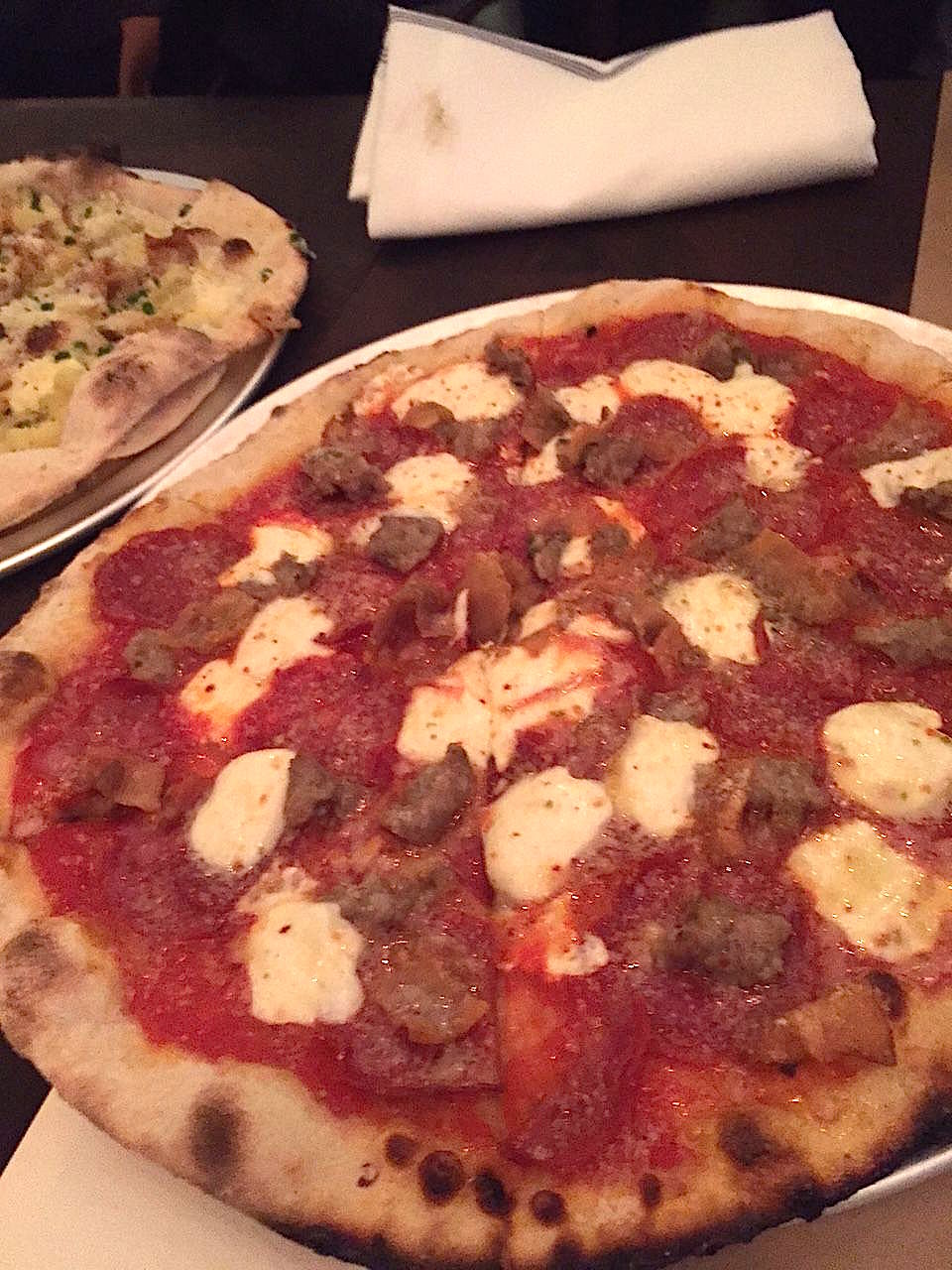
Martha Washington Hotel
29 East 29th Street
212-651-3800
martamanhattan.com
Located in the Martha
Washington Hotel and operated by the Union
Square Hospitality Group, Marta is an all-day
eatery that specializes in Roman-style,
thin-crusted pizzas, via Chef Nick Anderer
(also of the company’s Maialino), with Joe
Tarasco as chef de cuisine. Wine
director Jack Mason has put together a terrific,
long list of Italian regionals at all price
levels, with hard-to-find small estates from
Valle d’Aôsta to Sicily. Price
mark-ups are, by NYC standards, very reasonable,
with plenty of bottles under $50.
Marta is a huge,
high-ceilinged space, with a mezzanine above the
main dinning room that includes the kitchen
counter. The
service staff has its tempo down pat, but the
place is so loud that it’s very difficult to hear
their patter, and, after half an hour, the need to
ask one’s tablemates to repeat what they said
becomes wearying.
Restaurants need not, and should not, be
this loud--and music surely isn’t warranted to
keep things lively, since you can’t hear it anyway
through the bass and drums. There
are plenty of ways a designer or acoustical
technician can tamp down sound, even working with
all hard surfaces of dark tile floors and hard,
undressed tables.
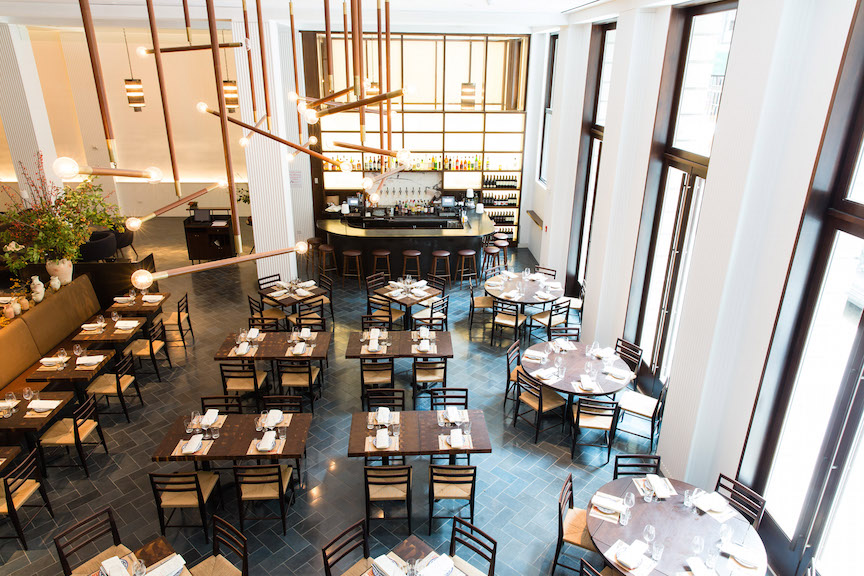 The pizzas
are good--we tried the delicious macellaio
(above)with
a topping of soppressata,
guanciale, pork sausage, mozzarella, and grana padano
($19) and patate
alla carbonara with potatoes, guanciale,
black pepper and egg ($18), which didn’t add up to
much in flavor.
At these prices--for relatively small
pizzas--with a $50 bottle of wine, maybe an
antipasto or two, tax and tip, you can easily run
up a bill of $130 for two people. Add in
main courses ($24-$36) and you’ve hit the big
leagues for Italian food.
The pizzas
are good--we tried the delicious macellaio
(above)with
a topping of soppressata,
guanciale, pork sausage, mozzarella, and grana padano
($19) and patate
alla carbonara with potatoes, guanciale,
black pepper and egg ($18), which didn’t add up to
much in flavor.
At these prices--for relatively small
pizzas--with a $50 bottle of wine, maybe an
antipasto or two, tax and tip, you can easily run
up a bill of $130 for two people. Add in
main courses ($24-$36) and you’ve hit the big
leagues for Italian food.
That said, the pizzas are of a
crackling, thin-crusted type, which is really more
like a flat bread than a pizza. They’re good, but
not what people
might expect when pizzas are so central to the
menu.
I enjoyed the antipasti of
green risotto croquettes called supplí
($7), but the rabbit meatballs with black olives
and ricotta ($14) were so-so.
Why Marta serves no pastas at
all, but offers four entrees, is puzzling indeed. For a
full-service, three-meals-a-day operation, it’s
not like they can’t handle a pasta station, the
way similar places like Roberto’s,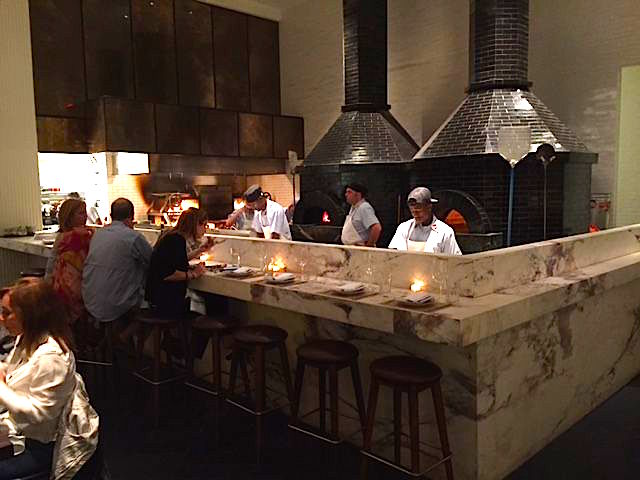 Naples 45, and Obica
do.
Naples 45, and Obica
do.
Oddly
enough, then, I preferred the three entrees I
tried, especially a superlative, big-proportioned
beef short rib ($34). Also recommend are the duck,
chicken and pork sausages (a good buy at $24) and
the succulent beer-brined half chicken ($25), some
of which I happily took home for lunch the next
day.
Dolci
include the increasingly trendy olive oil lemon
cake, but with a touch of spearmint ($8) and a
buckwheat tart with risotto and cherries ($8) that
was applaudably out of the ordinary. The coffees
here are decently priced, from $3 to $3.75.
Marta
is fun but, given the noise level, not for very
long. If they’d get that sound down to a
reasonable number of decibels and vary the styles
of pizzas, maybe add pastas, it could be a real
addition to highly competitive Italian trat scene
in NYC.
Open
daily for breakfast, lunch and dinner.
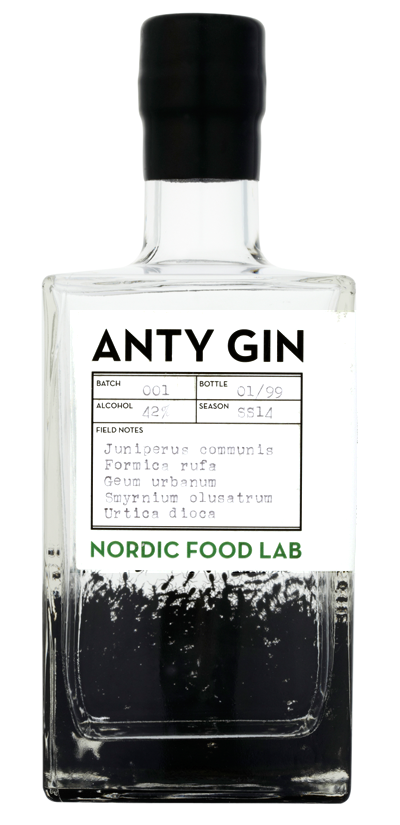 NEXT UP, BEETLEJUICE?
NEXT UP, BEETLEJUICE?
The Nordic Food Lab and Cambridge Distillery, has created “Anty Gin”: gin made with ants. Each $310 bottle of Anty Gin contains the essence 62 ants, mixing them with ethanol, juniper berries, botanicals, and nettle. "The result is a spectacular, one-of-a-kind gin that is being very well received worldwide,” creator Miles Irving, a professional forager, said. “People are astounded at how good it tastes. It's expensive because it's so labor intensive — Anty Gin was almost a year in the making."

DENTAL BE INCLUDED?
An American
chef working in Scotland posted a classifieds ad
for a line cook, with the heading, "Looking for someone
fast, progressive, and not a total **** for a new
restaurant in Clarkston." Further notes on the working
environment included:
• "It's a
breakfast/brunch/lunch place to start, but there are no
eggs Benedicts. Go on, wrap your head around that and
then continue reading. I'll wait."
• "If you have a cover letter that says you're a
'hard-working team player that can also function well
alone' and that you 'value customer service and
punctuality' I will stab myself in the face with a
pencil and nobody will get a job."
• "There's no money. There's £7/hr and some tips, 25-35
hours a week. Deal with it. Don't come to an interview
and then say it sounds great but you've got your kid's
school clothes to buy or whatever. I don't care."
• "What you cannot do is be a pain in my balls because
my life savings is on the line and I have to work with
my wife all day so I don't have time for any primadonna
bullshit."
• "If you think I sound like an obnoxious dickhead,
congratulations. You are observant and will go far in
life. Don't let it discourage you, though. I'm only a
dickhead for the first three years you know me. After
that I'm a total sweetheart."
Any of John Mariani's books below may be ordered from amazon.com.
 I'm proud and happy to announce that my
new book, The Hound
in Heaven (21st Century Lion Books), has just
been published through Amazon and Kindle.
I'm proud and happy to announce that my
new book, The Hound
in Heaven (21st Century Lion Books), has just
been published through Amazon and Kindle. It is a novella, and for anyone who loves dogs, Christmas, romance, inspiration, even the supernatural, I hope you'll find this to be a treasured favorite. The story concerns how, after a New England teacher, his wife and their two daughters adopt a stray puppy found in their barn in northern Maine, their lives seem full of promise. But when tragedy strikes, their wonderful dog Lazarus and the spirit of Christmas are the only things that may bring back his master back from the edge of despair.
WATCH THE VIDEO!
“What a huge surprise turn this story took! I was completely stunned! I truly enjoyed this book and its message.” – Actress Ali MacGraw
“He had me at Page One. The amount of heart, human insight, soul searching, and deft literary strength that John Mariani pours into this airtight novella is vertigo-inducing. Perhaps ‘wow’ would be the best comment.” – James Dalessandro, author of Bohemian Heart and 1906.
“John Mariani’s Hound in Heaven starts with a well-painted portrayal of an American family, along with the requisite dog. A surprise event flips the action of the novel and captures us for a voyage leading to a hopeful and heart-warming message. A page turning, one sitting read, it’s the perfect antidote for the winter and promotion of holiday celebration.” – Ann Pearlman, author of The Christmas Cookie Club and A Gift for my Sister.
“John Mariani’s concise, achingly beautiful novella pulls a literary rabbit out of a hat – a mash-up of the cosmic and the intimate, the tragic and the heart-warming – a Christmas tale for all ages, and all faiths. Read it to your children, read it to yourself… but read it. Early and often. Highly recommended.” – Jay Bonansinga, New York Times bestselling author of Pinkerton’s War, The Sinking of The Eastland, and The Walking Dead: The Road To Woodbury.
“Amazing things happen when you open your heart to an animal. The Hound in Heaven delivers a powerful story of healing that is forged in the spiritual relationship between a man and his best friend. The book brings a message of hope that can enrich our images of family, love, and loss.” – Dr. Barbara Royal, author of The Royal Treatment.
 |
The Encyclopedia of American Food and Drink by John F. Mariani (Bloomsbury USA, $35) Modesty forbids me to praise my own new book, but let me proudly say that it is an extensive revision of the 4th edition that appeared more than a decade ago, before locavores, molecular cuisine, modernist cuisine, the Food Network and so much more, now included. Word origins have been completely updated, as have per capita consumption and production stats. Most important, for the first time since publication in the 1980s, the book includes more than 100 biographies of Americans who have changed the way we cook, eat and drink -- from Fannie Farmer and Julia Child to Robert Mondavi and Thomas Keller. "This book is amazing! It has entries for everything from `abalone' to `zwieback,' plus more than 500 recipes for classic American dishes and drinks."--Devra First, The Boston Globe. "Much needed in any kitchen library."--Bon Appetit. |
"Eating Italian will never be the same after reading John Mariani's entertaining and savory gastronomical history of the cuisine of Italy and how it won over appetites worldwide. . . . This book is such a tasteful narrative that it will literally make you hungry for Italian food and arouse your appetite for gastronomical history."--Don Oldenburg, USA Today. "Italian
restaurants--some good, some glitzy--far
outnumber their French rivals. Many of
these establishments are zestfully described
in How Italian Food Conquered the World, an
entertaining and fact-filled chronicle by
food-and-wine correspondent John F.
Mariani."--Aram Bakshian Jr., Wall Street
Journal.
"Equal parts
history, sociology, gastronomy, and just
plain fun, How Italian Food Conquered the
World tells the captivating and delicious
story of the (let's face it) everybody's
favorite cuisine with clarity, verve and
more than one surprise."--Colman Andrews,
editorial director of The Daily
Meal.com. "A fantastic and fascinating
read, covering everything from the influence
of Venice's spice trade to the impact of
Italian immigrants in America and the
evolution of alta cucina. This book will
serve as a terrific resource to anyone
interested in the real story of Italian
food."--Mary Ann Esposito, host of PBS-TV's
Ciao
Italia. "John Mariani has written the
definitive history of how Italians won their
way into our hearts, minds, and
stomachs. It's a story of pleasure over
pomp and taste over technique."--Danny Meyer,
owner of NYC restaurants Union Square
Cafe, The Modern, and Maialino.
|
 |
 |
 |
 |
 |
 |
 |
 |
 Everett Potter's Travel Report:
Everett Potter's Travel Report: 
 Eating Las
Vegas is the new on-line site for
Virtual Gourmet contributor John A. Curtas.,
who since 1995 has been commenting on the
Las Vegas food scene and reviewing
restaurants for Nevada Public Radio.
He is also the restaurant critic for KLAS
TV, Channel 8 in Las Vegas, and his past
reviews can be accessed at KNPR.org.
Click on the logo below to go directly to
his site.
Eating Las
Vegas is the new on-line site for
Virtual Gourmet contributor John A. Curtas.,
who since 1995 has been commenting on the
Las Vegas food scene and reviewing
restaurants for Nevada Public Radio.
He is also the restaurant critic for KLAS
TV, Channel 8 in Las Vegas, and his past
reviews can be accessed at KNPR.org.
Click on the logo below to go directly to
his site.

Tennis Resorts Online: A Critical Guide to the World's Best Tennis Resorts and Tennis Camps, published by ROGER COX, who has spent more than two decades writing about tennis travel, including a 17-year stretch for Tennis magazine. He has also written for Arthur Frommer's Budget Travel, New York Magazine, Travel & Leisure, Esquire, Money, USTA Magazine, Men's Journal, and The Robb Report. He has authored two books-The World's Best Tennis Vacations (Stephen Greene Press/Viking Penguin, 1990) and The Best Places to Stay in the Rockies (Houghton Mifflin, 1992 & 1994), and the Melbourne (Australia) chapter to the Wall Street Journal Business Guide to Cities of the Pacific Rim (Fodor's Travel Guides, 1991).


MARIANI'S VIRTUAL GOURMET
NEWSLETTER is published weekly. Editor/Publisher: John
Mariani.
Editor: Walter Bagley. Contributing Writers: Christopher Mariani,
Robert Mariani, Misha
Mariani,
John A. Curtas, Edward Brivio, Mort Hochstein,
Andrew Chalk, Dotty Griffith and Brian Freedman. Contributing
Photographers: Galina Dargery, Bobby
Pirillo. Technical Advisor: Gerry McLoughlin.
To un-subscribe from this newsletter,click here.
© copyright John Mariani 2015

